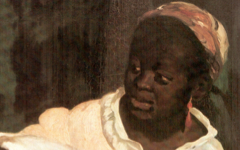Manet’s At the Prado

Top L: Manet, At the Prado I, Etching, 1st state
Top C: Manet, At the Prado II, Etching, 1st State
Bottom: Manet, Exhibition of Paintings (diagram indicating "Velazquez's figure")
Click image to enlarge.
Two of Manet’s earliest etchings are called At the Prado (left and center). The Prado is the museum in Madrid where Velazquez' Las Meninas was the crown jewel though Manet had not yet visited Spain. The foreground figure in each etching has a crooked arm like Velazquez’s brush arm in Las Meninas. One of their heads also leans to the side like Velazquez’s. At left we compare the two etchings to a detail of Manet’s modern take on Las Meninas, An Exhibition of Pictures.
Click next thumbnail to continue

L: Manet, At the Prado I (detail)
C: Manet, At the Prado II (detail)
R: Velazquez, Las Meninas (detail)
Click image to enlarge.
Comparing both women to Velazquez’s actual self-portrait makes the link clearer. The crooked arm for a “brush arm”, sometimes combined with the head leaning to one side like Velazquez’s, became one of Manet’s principal forms for an artist.
Click next thumbnail to continue

L: Velazquez, Las Meninas (detail of Infanta)
C: Manet, At the Prado I (detail)
R: Velazquez, Las Meninas (detail of self-portrait)
Click image to enlarge.
There is also a reason why the head of the woman in At The Prado I (center) does not lean to the side like Velazquez's. She is a fusion of both artist and model, that is to say Velazquez and the Infanta. Her head is based on the Infanta’s (left), her bent arm on Velazquez (right). Since every painter paints himself, artist and model are always one, whether in a seventeenth-century Spanish masterpiece or a nineteenth-century French etching.
Click next thumbnail to continue

Top: Details of three paintings by Manet, Angelina, The Spanish Dancer and Mme. Brunet
Bottom: Velazquez, Las Meninas (detail of self-portrait)
Click image to enlarge.
In other single-figure paintings by Manet the crooked arm frequently reappears. It has already been shown how Angelina (far left) with her bent arm is based on Velazquez (bottom); now we can reveal that two other figures, The Spanish Dancer (center) and Mme Brunet (right), are as well. Angelina (left) carries a Spanish fan in Velazquez’s honor while Mme. Brunet holds a pair of yellow gloves, an identifying mark of Manet himself whom, it is said, never left home without them.1
See conclusion below
The crooked arm is not just a favorite pose of Manet's that he repetitively used because it looked elegant. The form had meaning because it derived from Velazquez's bent arm in Las Meninas. This is a lesson in the importance of an artist's sources. Without knowing where they come from, one is danger of losing most if not all of their meaning.
More Works by Manet
Notes:
1. Armstrong discusses the significance of Manet's yellow gloves and why they appear in so many of his paintings. See Carol Armstrong, Manet Manette (Yale University Press) 2002, pp. 308-12
Original Publication Date on EPPH: 30 Jan 2011. | Updated: 0. © Simon Abrahams. Articles on this site are the copyright of Simon Abrahams. To use copyrighted material in print or other media for purposes beyond 'fair use', you must obtain permission from the copyright owner. Websites may link to this page without permission (please do) but may not reproduce the material on their own site without crediting Simon Abrahams and EPPH.



